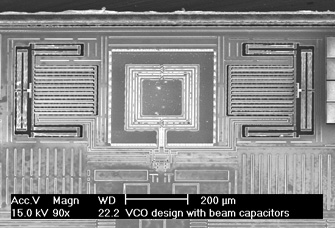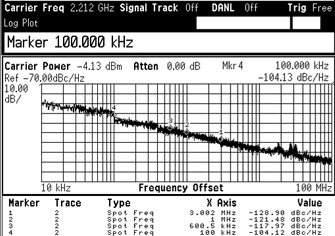
 |
|||||||
Low Power Reconfigurable RF LC VCO using MEMS based passives |
|||||
|
Vivek Saraf Advisor: Tamal Mukherjee |
 Comparison tables showing attractive FoM and wide tuning range  SEM of the VC  Measured Phase Noise Plot |
||||
|
Project: The Voltage Controlled Oscillator (VCO) is targeted for use in a dual frequency-hopped receiver configuration to be used for portable applications. The key requirements of this architecture are integration, low power and wide tuning range. Micromachined passives enables low power operation through increased quality factors (Q) and wide tuning range through digital reconfiguration. Integration is achieved by using foundry provided metal interconnect layers for building these passives. Low Power & Wide Tuning Range VCO Design For low power operation, there are 2 features of the tank which are desirable – bigger inductor (so that a smaller capacitance can be used in the tank, and hence lesser power dissipation, for the same carrier frequency) and higher Q for the inductor (since the Q of the tank is dominated by the Q of the inductor, and not only does phase noise improve quadratically with Q, but a higher Q allows a smaller current to start oscillations, and hence decreased power consumption). Both these objectives are achieved with the use of micromachined inductors. Micromachining leads to reduced substrate coupling capacitance causing not only an increase in inductor self-resonance, resulting in an increased Q at higher frequencies, but also allows the usage of bigger inductors. The decreased power combined with higher operating fequency and comparable phase noise results in an attractive figure of merit, comparisons of which are shown in Fig. 1(a). The VCO also uses micromachined reconfigurable capacitors for digital tuning for extending the tuning range in addition to fine tuning using varactor diodes. The advantage of using the low parasitic linear MEMS capacitor in parallel with the tank is that it allows an extension of the tuning range without any degradation of phase noise or the requirement of any additional mixed-signal control. The linearity of the MEMS capacitors avoids any AM-FM conversion, leading to better phase noise without the need of a series implementation to achieve that at the expense of tuning range. Comparisons to previously published work can be seen in Fig. 1(b).
|
|||||
|
References: [1] Bergveld, P. , Olthuis, W., Sprenkels, A.J., Pijanowska, D.,Linden, H.J. van der, Bohm, S. Integrated Analytical Systems,Comprehensive Analytical Chemistry Series, 39, pp. 625-663, 2003 [2] Mulder, M., Basic Principles of Membrane Technology, Kluwer Academic Publishers: The Netherlands, 199 |
|||||
|
overview | projects | people | publications | intranet | resources © 1998-2009 Carnegie Mellon |